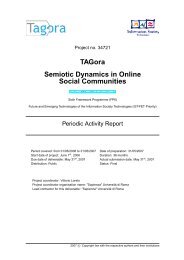NoiseTube: Measuring and mapping noise pollution with mobile ...
NoiseTube: Measuring and mapping noise pollution with mobile ...
NoiseTube: Measuring and mapping noise pollution with mobile ...
Create successful ePaper yourself
Turn your PDF publications into a flip-book with our unique Google optimized e-Paper software.
<strong>and</strong> provide qualitative input for the monitoring of urban <strong>noise</strong> <strong>pollution</strong>.<br />
In this section we discuss <strong>and</strong> motivate this approach in detail.<br />
3.1 Mobile phone as an environmental sensor<br />
The growing popularity of smart phones <strong>with</strong> high computational power,<br />
Internet access <strong>and</strong> integrated sensors (e.g. cameras, GPS, motion sensors)<br />
represent a cheap but powerful WSN platform that is readily available <strong>and</strong><br />
widely deployed. In this perspective <strong>mobile</strong> phones can serve as sensors<br />
which are carried by humans rather than placed at static locations. In addition<br />
to carrying around sensors, citizens can also be more directly involved<br />
in the sensing process by entering qualitative inputs (<strong>noise</strong> source tagging,<br />
annoyance rating). Thanks to the aggregated mobility of users, this approach<br />
enables sensing coverage of large public spaces over time long periods<br />
of time.<br />
3.1.1 Mobile sensing<br />
This idea is related to the concept of participatory sensing [4], which advocates<br />
the use of <strong>mobile</strong> devices to form sensor networks that enable public<br />
<strong>and</strong> professional users to gather, analyze <strong>and</strong> share local knowledge. At<br />
the same time, people as individuals or in groups can apply these new<br />
sensing networks <strong>with</strong> a more personal focus. Their individual stories of<br />
everyday life can be aggregated to document the urban environment, fed<br />
back into a collective experience in urban public spaces, enabling peoplecentric<br />
sensing [5], for personal, peer or public purposes.<br />
3.1.2 Democratising <strong>noise</strong> <strong>pollution</strong> measurement<br />
Despite some research projects involving volunteers <strong>and</strong> specific measurement<br />
devices, e.g. for air <strong>pollution</strong> monitoring [21] the participatory<br />
sensing paradigm has not been validated empirically by real world use in<br />
an environmental domain due to the cost <strong>and</strong> lack of access to environmental<br />
sensors for the general public. In the context of <strong>noise</strong> <strong>pollution</strong>, by<br />
turning <strong>mobile</strong> phones into <strong>noise</strong> <strong>pollution</strong> sensors, we strongly lower the<br />
entrance barrier of such environmental measurement technology.<br />
<strong>NoiseTube</strong> has the potential to set up new kinds of experiments by enlarging<br />
the scope of potential participants. In the spirit of the Web 2.0 culture<br />
[20] <strong>and</strong> its user-generated content model, we expect novel <strong>mobile</strong> device<br />
applications <strong>and</strong> networked participation models to emerge for environmental<br />
monitoring (e.g. for <strong>noise</strong> <strong>pollution</strong>) that fully tap into the potential<br />
of citizen science [22].




